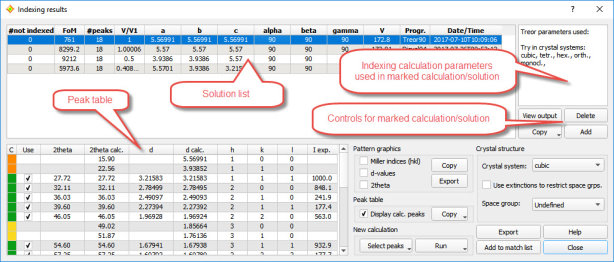Indexing
Go to Match! Features Overview...
Previous: Rietveld refinement...
Next: Crystal structure solution using Endeavour...
Indexing, the derivation of unit cell parameters from
given peak positions in a powder diffraction pattern, is a mandatory step in
crystal
structure solution from powder diffraction data. Knowing the unit cell
can also be very useful in qualitative phase analysis, considering that cell parameters can be
used as restraints.
Match! can use two of the most prominent
programs for indexing: Treor90 and Dicvol.
All that is required to run an indexing calculation are either experimental peaks or
raw diffraction data. If only raw (profile) but no peak data are present,
Match! will automatically execute the raw data
processing before the actual indexing calculation is started.
Before running the "Indexing" command, you should mark the peaks to be
taken into account in the indexing calculation. If you do not mark any peaks, Match! will automatically use the 20 strongest peaks (if present) that are not yet covered by
selected phases and whose relative intensity is larger than the
corresponding minimum value (which can e.g. be adjusted using the red bar on the y-axis of the
diffraction pattern graphics) for indexing.
Once you have run the indexing command and maybe selected an indexing program,
a parameter settings dialog will be displayed. Afterwards, the indexing
calculation will be run.
When the calculation has finished successfully, you will be presented with one
(or even a table of) potential solution(s). After accepting one (or more) solution(s),
you will be taken to the �Indexing results� dialog (see below) where you can evaluate the solutions (i.e. unit cells),
refine unit cell parameters, inspect peak data, select crystal system and space group (or let Match! or Dicvol
do so automatically), and maybe add the
solution as a new manual entry to the match list (e.g. to proceed with
structure solution).

Go to Match! Features Overview...
Previous: Rietveld refinement...
Next: Crystal structure solution using Endeavour...
|

